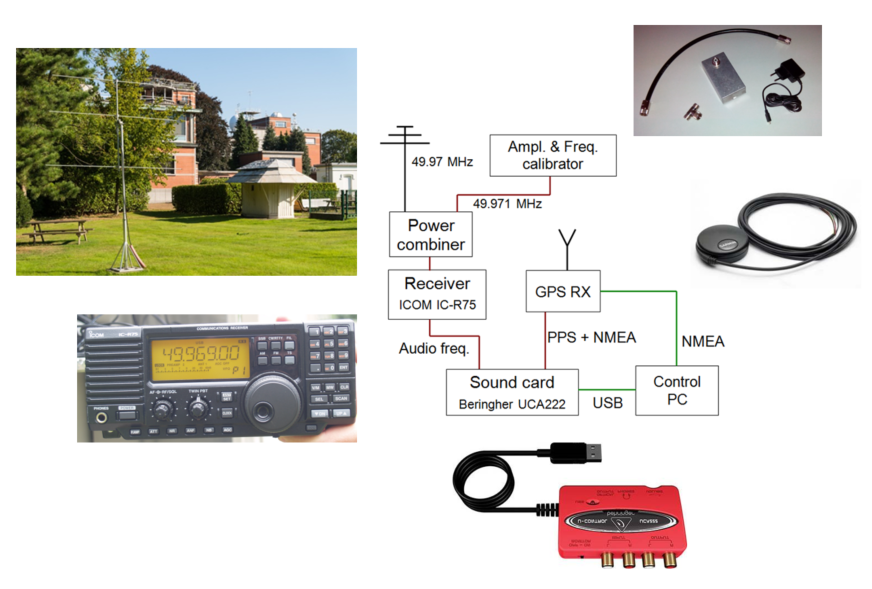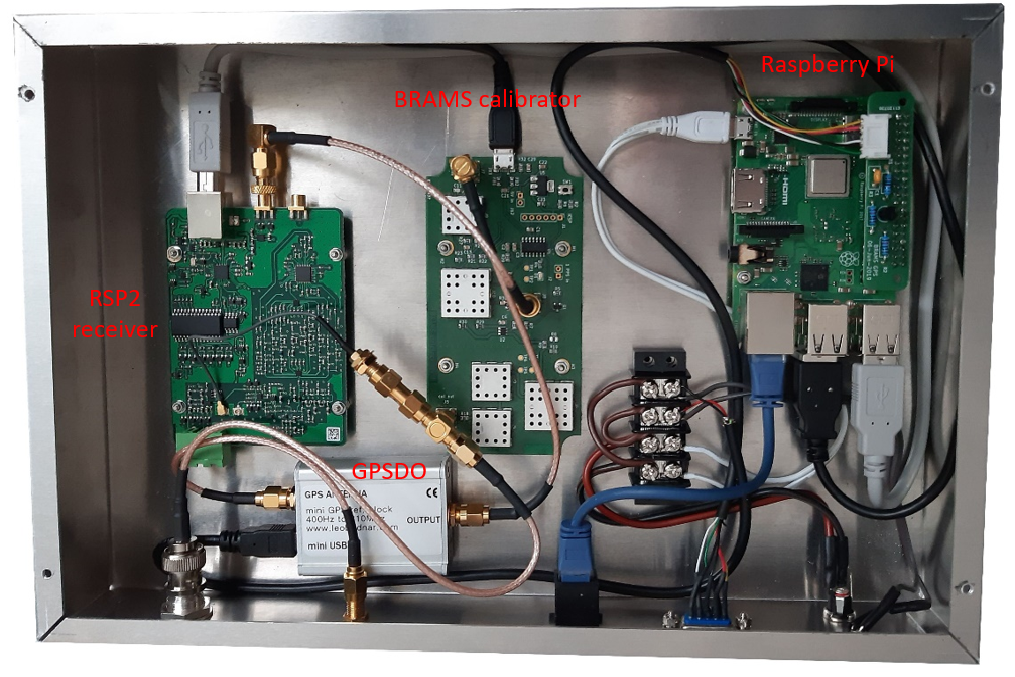There are currently two types of receiving stations in the BRAMS network depending on the kind of receivers used. Both systems use a 3-element Yagi antenna oriented vertically such that properties of the ground do not modify significantly the radiation pattern of the antenna. Antennas and receivers are connected using RG213 RF cables. Below is a picture of our antenna located in the RMI park close to our institute.

The first receiving stations are using an analog receiver, the ICOM-R75, that shifts the RF signal from 49.97 MHz to around 1 KHz by adjusting the internal local oscillator (LO) to 49.969 MHz (in USB mode). This receiver was chosen at the beginning of the project because it was relatively cheap and had the option of setting the Automatic Gain Control (AGC) off.
The signal is then sampled using an external Behringer UCA222 sound card at a sampling rate of 22050 Hz. The sound card samples simultaneously the signal coming from the antenna and a signal coming from a Garmin GPS Clock. The latter sends 1 PPS signal followed by NMEA data containing among others the information about the second associated to the previous PPS. The high cadence of the sampling rate was chosen to ensure that the NMEA data were sampled correctly.
The sound card is connected by USB to a local PC where Spectrum Lab is running and piloting the system. The GPS clock is also connected to the PC in order to synchronize its clock. Data are saved every 5 minutes in a WAV format. Live data can be seen with Spectrum Lab.
An additional device has been added since around 2015. It is called the BRAMS calibrator, a device that provides a very stable signal both in amplitude and frequency. The signal generated by the BRAMS calibrator is combined with the signal coming from the antenna using a simple T. The chosen frequency is 49.9705 MHz, i.e. 500 Hz above the signal from the transmitter. Its amplitude is accurately measured and is around -130 dBm, comparable to the direct signal coming from the transmitter for stations relatively close, and not strong enough to avoid saturation.
In March 2021, 23 out of 37 receiving stations still use this material. The picture below shows the material used and a block diagram.

Around 2018-19, it became clear that a new type of receiving stations was needed. First, the ICOM-R75 were failing one after another after a long continuous use during several years. This problem led to a progressive lack of sensitivities of the receivers. Although we were able to replace the broken components, a new solution was considered for several reasons. The ICOM-R75 were difficult to find, became more and more expensive and eventually were not produced anymore.
Similar analog receivers with the option of setting AGC off were extremely expensive. Moreover, the tendency in the market was to use SDR receivers. Hence we decided to use RSP2 receivers which have also the advantage of having a higher dynamic range and a better sensitivity than the ICOM-R75. They are also significantly cheaper. But a whole new concept had to be defined because RSP2 does not allow simultaneous sampling of the signals from the antenna and GPS. Details can be found in this presentation.
The RSP2 receiver is piloted by a Raspberry Pi. Its clock is synchronized with the PPS of the same Garmin GPS. The LO of the RSP2 is stabilized using an external 24 MHz reference provided by a GPSDO (GPS Disciplined Oscillator).
Two different GPS clocks are therefore used in this new system, one for timing, the other one for frequency stability. As a consequence, the direct signal of the transmitter appears at exactly 1 KHz and the signal from the calibrator at 1.5 KHz with no frequency drift at all. This was an issue with ICOM-R75 receivers as well since their LO could not be locked using an external reference, leading sometimes to strong and fast frequency drifts (e.g. when the receiver was starting and therefore warming) or slow moderate frequency drifts (due to variations of temperatures in the local).
Although not visible in the picture below, the BRAMS calibrator is of course still used in these new stations. In March 2021, this material is currently used in 10 stations.

In 2020, it was decided to install all the material into one metallic box that would be more compact, safer for the material, and easy to use (kind of plug & play). It has an additional advantage: the reference signal from the GPSDO is also used to stabilize the LO of the BRAMS calibrator. This box has already been installed at 3 stations in March 2021.







